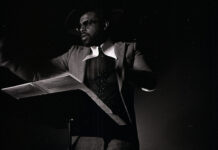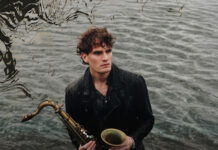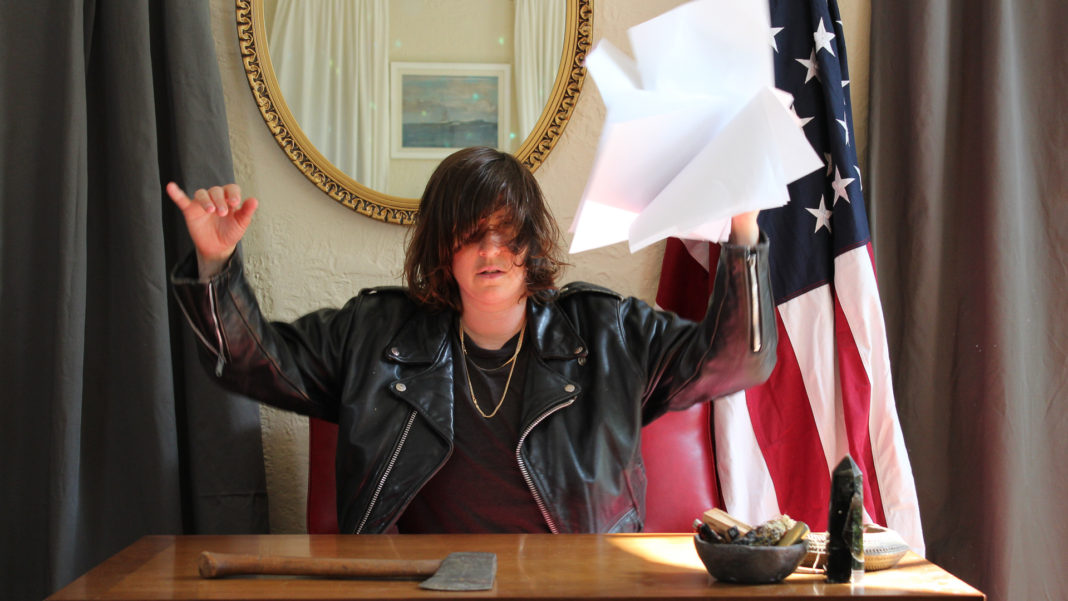During what can politely be called one of the most unorthodox presidential campaign seasons in the history of our country, it is easy to forget there was once a time when we turned to our elected leaders for comfort, for reason and for honesty. Over the course of 11 years, Franklin Delano Roosevelt gave 30 addresses to the nation about his policies, the state of the world, the depression and World War II. They became known as the Fireside Chats. Those chats have inspired Constance Hockaday to create a series of new such chats for our time called Artists-In-Presidents.
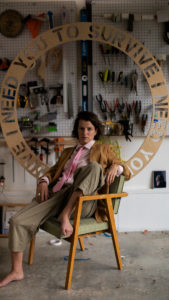
The series, which launched in September and runs through mid-November, finds 53 different artists* presenting their own version of a modern-day fireside chat. Every artist was encouraged to create the kind of speech he/she/they would give the nation today. Additionally each was asked to come up with an official portrait, much like each president has had created.
Hockaday conceived of Artists-In-Presidents, assembled the artists and consulted with them on their addresses. The project was created and produced with UCLA’s Center for the Art of Performance and Stanford Live Arts.
She is a visual artist and director who is, in her own words, “…interested in waters and creating public access to that water and the ways in which we engage in public space.” As you’ll read below, water comes into play with the inspiration for this project.
Two weeks ago I spoke with Hockaday about that inspiration, how the dialogue between politicians and the public has changed and whether something FDR said in his final address to the country still holds true.
What follows are excerpts from that interview that have been edited for clarity and length.
The introduction to Artists-In-Presidents says that Roosevelt changed forever the way a president communicated with the country. Has Donald Trump done the same thing?
Yeah. It remains to be seen whether or not it will actually change the country forever, we don’t know that yet. When Roosevelt came into power he knew he had to make his presidency a religious experience – speak to the public’s faith in democracy and faith in collective agreement and government and in participating in it. He did that through radio.
Part of the reason this project is interesting in this moment is that Trump has also shifted the rhetoric of the president in this moment. His reach and his aspirations are much more narrow than Roosevelt’s. FDR was really working to speak to an American mass public. Trump is altering the rhetoric and directing it at a fraction of the country. He is speaking differently than we’ve ever seen and using Twitter differently than any other president.
Is the fear that he might radically change that way a president communicates one of the motivations for Artists-In-Presidents?
No. This project actually started before Trump. I began working on this is in 2015. It was connected to Roosevelt’s retired presidental yacht which is docked in Oakland. I became really enamored when I figured out the yacht is where he went to write and think during all four terms. It was the floating White House.
I got really excited about co-opting this vestige of president power and blowing open the vessel and creating a social club and remaking new fireside chats. The idea was to reclaim this tool that was so effective and recreate it to create voices that repped a majority of Americans in this country right now.
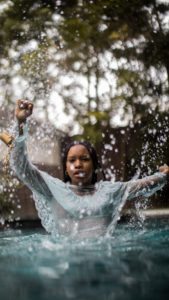
I was motivated by 2018 statistic that showed 90% of the people who run for office were white men, but women of color are winning at the same rate. Women and people of color have to imagine themselves in positions of leadership before running for office. It was an experiment in seeing what all different versions of leadership could look like.
It’s about shifting our experience, our collective public understanding, of leadership looking like a clean-cut well-dressed white man in a suit. It’s also about people who are not that and they have to realize they have to rise to a position of leadership and that they have the right to do that.
You ask the question what would it be like if presidential power came from us. Has this project allowed you to answer your own question?
I think the biggest takeaway is that a single man speaking for us all and speaking to us all – there are limitations to that. Our leaders speak about Black people and immigrant children in cages or transgender people, but there’s rarely a president or public leader who can hold the space and speak directly to these people who are suffering.
I think if presidential power came from us it would be a multi-vocal chorus of people. It would never be just one of us. I don’t agree with every single thing this project is producing, but I don’t want to see this group of voices without every single one of those pieces in the pot. I feel like the artists are able to articulate and perform what’s missing from leadership now.
In his last message to the American people, Roosevelt said, “Today we are faced with the pre-eminent fact that if civilization is to survive, we must cultivate the science of human relationships – the ability of all peoples, of all kinds, to live together and work together, in the same world, at peace.” That was 75 years ago. Does that still resonate and, if so, what does that say about how far, or not, we’ve come since 1945?
I just don’t think our work in this vein will ever be done. If our most intimate relationships are proof of anything– to love and care and live together– is a commitment to those things in action into perpetuity.
Do I think they we have had the opportunity to root out racism and sexism in all its forms over the last 75 years… yes. The opportunity has been there but never as vibrantly, as fiercely, as we are experiencing it now. Are the working classes better off then they were 75 years ago… NO. Are the wealthy classes finding more ways to protect their power and becoming untouchable in this world economic system… YES.
I think as individuals and small communities we are growing, but as an empire we are the same as we always have been.
Note: The final answer came via e-mail and the text is presented as received. The emphasis is Hockaday’s.
*Kyla Abraham, Nao Bustamante, Mel Chin, Gabrielle Civil, Sofia Cordova, Sasha Debevec-McKenney, Dot Devota, Yasmine Nassar Diaz, Mariana Dietl, Sartia Dougherty, Edgar Fabian Frias, Coco Fusco, Madame Gandhi, Jonathan Gozalez, Miguel Gutierrez, Deanna Haggag, Ann Hamilton, A. Haq, Asher Hartman, Philth Haus, Celeste Headlee, Keith Hennessy, Lewis Hyde, Xandra Ibarra, Daniel Alexander Jones, Miranda July, Rosamond S. King, Amma Ghartey-Tagoe Kootin, Cara Levine, Dylan Mira, Alexis Moh, My Other Me, Eileen Myles, Jasmine Nyende, Okwui Okpokwasili, Eiko Otake, Pavritha Prasad, Brontez Purnell, Ishmael Reed, Jen Delos Reyes, Ridykeulous, Nibia Pastrana Santiago, Kanyon Sayers-Roods, Alice Sheppard, Roger Guenveur Smith, Casey Spooner, Kennedy Tezano, Carmelia Tropicana, Nafis White, Mandy Harris Williams, Kristina Wong and گاف.
Photo: Constance Hockaday (Photo courtesy of CAP UCLA)


